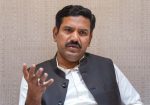
Budget 2020 glossary: A layman’s guide to understanding key terms
Team Udayavani, Jan 29, 2020, 6:49 PM IST

Understanding the Union budget in its entirety is a difficult process as it involves complex terms, which are indicators of the country’s financial performance. People often fail to understand key terms such as the fiscal deficit, cess, revenue receipts and many more.
Here are the terms explained in detail to help you expand your budget vocabulary:
Banking cash transaction tax (BCTT) – A direct tax levied on withdrawal of cash more than a specified limit from bank.
Capital expenditure – The money spent by the government on the development of machinery, equipment, building, health facilities, education, etc. It also includes the expenditure incurred on acquiring fixed assets like land and investment by the government that gives profits or dividend in future.
Capital receipts – These are loans taken by the government from the public, borrowings from foreign countries and institutes and borrowings from the RBI. Recovery of loans given by the Centre to states and others is also included in capital receipts.
Cess – A cess is a form of tax levied by the government on for specific purposes. A cess is imposed as an additional tax alongwith an existing tax. For example, the Swachh Bharat cess is levied by the government for cleanliness activities that it is undertaking across India.
Consolidated Fund of India – Constituted under Article 266(1) of the Indian Constitution, the Consolidated Fund is the account in which the revenues of the Government of India — via income tax, Customs, central excise and the non-tax revenue — is deposited. Expenditure incurred too is credited from here.
Contingency Fund of India – It is the emergency fund constituted under Article 267(1) of the Indian Constitution. The contingency fund is used at a time when there is a crisis in the nation — a natural calamity, for instance — and money is required to deal with it.
Countervailing duty (CVD) – It is a specific form of duty that the government imposes in order to protect domestic producers by countering the negative impact of import subsidies. The duty nullifies and eliminates the price advantage (low price) enjoyed by an imported product when it is given subsidies or exempted from domestic taxes in the country where they are manufactured.
Current Account Deficit (CAD) – It is the shortfall between the money received by selling products to other countries and the money spent to buy goods and services from other nations. If the value of goods and services we import exceeds the value of those we export, the country is said to be in a deficit, and the difference in the two values is CAD.
Cut motion – It is a special power vested in members of the Lok Sabha to oppose a demand being discussed for specific allocation by the government in the Finance Bill.
Excess grant – It is the money given to the government when the already allocated money for expenditure for that year not enough and extra money is required.
Expenditure budget – This is a budget of the government that shows the allotment of funds for disbursement to different ministries, sectors, departments in a financial year as part of the Union Budget.
Expenditure profile – It provides an expenditure summary of the Union government which includes actual revenues and capital spent in the previous financial year and the budgeted and revised estimates for the current financial year, besides estimates for the upcoming financial year.
Fiscal deficit – It is the total money spent by the government in excess of its income. The income figure includes only taxes and other revenues and excludes money borrowed to make up the shortfall.
Macro-economic framework statement – It is a statement containing an overview of the economy including an assessment of the GDP growth rate, fiscal balance of the central government and the external sector balance of the economy. It makes an assessment of growth prospects for the economy with regards to specific underlying assumptions.
Minimum alternate tax (MAT) – Companies sometimes show nil taxable income despite making substantial profits and paying out dividends. This happens because of various tax concessions and incentives. MAT was created to bring these ‘zero-tax paying companies’ within the ambit of income tax and make them pay a minimum amount in tax to the government.
Monetised deficit – It is the monetary support the Reserve Bank of India (RBI) extends to the Centre government as part of its borrowing programme. In other words, the central bank purchases government bonds to finance the spending needs of the government.
Non-plan expenditure – It is the government expenditure spent on the so-called non-productive areas such as salaries, subsidies, loans and interest.
Receipts budget – It is an extensive list of the income generated from different sources by the government in a financial year. It shows the break-up of revenue generated under different heads.
Revenue receipts – It is the proceeds government receives from taxes and other duties levied by the Centre: interest and dividend from its investments and the fees and charges the government receives for its services.
Ways and Means Advances (WMA) – It is a temporary loan given by the Reserve Bank of India (RBI) to the central and state governments.
Zero-based Budget – It refers to planning and preparing the Budget from scratch or ‘zero base.’ A traditional Budget is based on previous Budgets. In zero-based Budget, no balances are carried forward, and there are no pre-committed expenses. It emphasises the identification of a task and funding of costs irrespective of the current structure of the expenditure.
Udayavani is now on Telegram. Click here to join our channel and stay updated with the latest news.
Top News
Related Articles More

LS 2024: Yet another face-off between seasoned politicians Kota Srinivas Poojary & Jayaprakash Hegde

Wish to work for betterment of my state Odisha: UPSC 2nd rank holder Animesh Pradhan
Climate change is causing marine ‘coldwaves’ too, killing wildlife

Celebrating Vishu: A Tapestry of Traditions Across India

‘Sangh values’ run through my veins; can’t think of filling mother’s shoes: Bansuri Swaraj
MUST WATCH
Latest Additions

Injuries don’t define you: Mohammed Shami shares rehab update

Shivakumar desperately wants to become CM, says K’taka BJP chief Vijayendra

Scribe throws lapel microphone towards Sharad Pawar in Baramati; cops give clean chit

India delivers first batch of BrahMos missiles to Philippines

Air India cancels Dubai flights due to operational disruptions

























